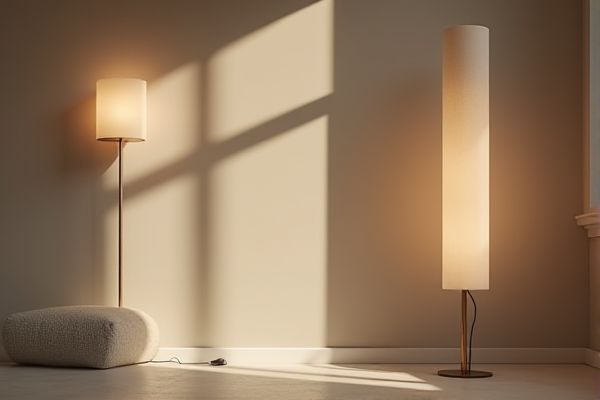
Wall sconces save floor space and provide ambient or accent lighting, making them ideal for smaller rooms or hallways, while floor lamps offer versatile, movable lighting solutions perfect for reading corners or living rooms. Explore the rest of the article to discover which option suits your lighting needs best.
Table of Comparison
| Feature | Wall Sconce | Floor Lamp |
|---|---|---|
| Installation | Mounted on wall, requires secure fixing and sometimes wiring | Freestanding, no installation needed, just plug in |
| Space Usage | Saves floor space, ideal for small rooms | Occupies floor space, suitable for larger areas |
| Lighting Direction | Often directs light upward or sideways, ambient lighting | Flexible direction, can provide task or ambient lighting |
| Style Options | Varied styles, modern to classic, enhances wall decor | Wide range from minimalist to ornate, adds room accent |
| Portability | Fixed position, not portable | Mobile, easy to move and reposition |
| Power Source | Hardwired or plug-in | Plug-in powered |
| Cost | Moderate to high due to installation | Typically affordable, no installation cost |
Wall Sconce vs Floor Lamp: Key Differences
Wall sconces are mounted on walls, providing ambient or accent lighting while saving floor space, making them ideal for smaller rooms or hallways. Floor lamps are freestanding fixtures that offer versatile, often task-oriented lighting and can be easily moved or adjusted according to your needs. The choice between wall sconces and floor lamps depends on your room layout, lighting requirements, and design preferences.
Design and Style Considerations
Wall sconces offer a sleek, space-saving design ideal for adding ambient or accent lighting without occupying floor area, often featuring minimalist or classic styles that blend seamlessly with various interiors. Floor lamps provide versatile lighting options with diverse designs ranging from contemporary to traditional, serving as statement pieces that can anchor a room's decor while delivering task or ambient light. Selecting between wall sconces and floor lamps depends on spatial constraints and desired aesthetic impact, balancing functionality with style harmonization in living spaces.
Space and Placement Flexibility
Wall sconces save valuable floor space by mounting directly on walls, making them ideal for small rooms or narrow hallways where floor area is limited. Floor lamps offer greater placement flexibility, easily moved or repositioned to suit changing lighting needs or room layouts without requiring installation. Your choice depends on whether you prioritize fixed, space-saving lighting or adaptable illumination options that can be relocated effortlessly.
Lighting Functionality and Purpose
Wall sconces provide focused, ambient lighting ideal for accentuating artwork or creating mood lighting in hallways and smaller spaces, maximizing wall space without cluttering floors. Floor lamps offer versatile illumination with adjustable brightness and positioning, making them suitable for task lighting in living rooms or reading nooks. The choice depends on spatial constraints and lighting needs, with wall sconces enhancing decor while floor lamps deliver functional, portable light.
Installation and Setup
Wall sconces require mounting on walls using screws and anchors, making their installation more permanent and suited for rooms with accessible wall space. Floor lamps offer a flexible setup with no drilling needed; you simply place them on the floor and plug them into a nearby outlet. Your choice depends on whether you prefer a fixed lighting solution or one that can be easily moved and adjusted.
Energy Efficiency Comparison
Wall sconces typically offer greater energy efficiency due to their fixed placement and use of LED or low-wattage bulbs, reducing unnecessary power consumption. Floor lamps often consume more energy as they illuminate larger areas and use higher wattage bulbs to provide adequate lighting. Choosing a wall sconce can help you optimize your home's energy usage while maintaining effective lighting.
Cost and Maintenance
Wall sconces generally have a lower upfront cost and require minimal maintenance since they are fixed installations with fewer components exposed to damage. Floor lamps often come with higher prices due to portability, varied designs, and additional features like adjustable brightness, but their maintenance can be more frequent, including bulb replacements and stability checks. Choosing between wall sconces and floor lamps depends on budget constraints and willingness to perform regular upkeep.
Ideal Rooms and Use Cases
Wall sconces suit narrow hallways, bathrooms, and bedrooms where space-saving lighting is essential, providing ambient or accent light without cluttering floors. Floor lamps excel in living rooms, reading nooks, and offices, offering versatile task lighting with portability and adjustable brightness. Choosing between them depends on room size, layout, and desired lighting functionality.
Pros and Cons of Wall Sconces
Wall sconces offer space-saving lighting solutions ideal for narrow or small rooms, providing ambient or accent light without occupying floor space. However, their fixed placement limits flexibility, and installation typically requires electrical work, which might increase costs. You can enhance your interior design by selecting sconces that complement your decor while considering these trade-offs.
Pros and Cons of Floor Lamps
Floor lamps provide versatile lighting options and can easily be moved to different room areas, making them ideal for flexible space arrangements. They require floor space and may create clutter in smaller rooms, limiting placement options compared to wall sconces. Floor lamps often offer adjustable brightness levels and styles, but they depend on power outlets and can pose tripping hazards.
 homyna.com
homyna.com